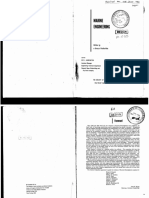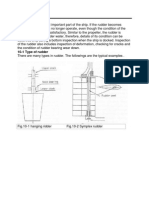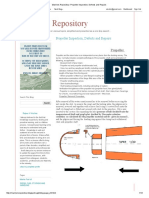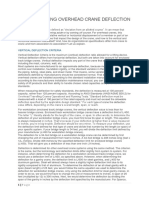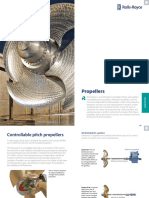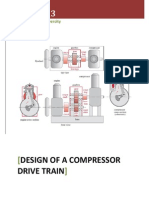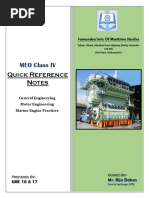Alignment Instructions
Uploaded by
krishnaprasad_rajaseAlignment Instructions
Uploaded by
krishnaprasad_rajaseRESTRICTED
CHAPTER-1
INTRODUCTION
Shaft Alignment
1. The propulsion shafting alignment is a process, which consists
of two parts:
The design and analysis
The alignment procedure and measurements
The terminology and requirements for the shaft alignment will vary
depending on the machinery application, the propulsion systems
size, as well as on the perception of the alignment process itself.
Propulsion shafting is a system of revolving rods that transmit
power and motion from the main drive to the propeller. The shafting
is supported by an appropriate number of bearings. Propulsion
shaft alignment is a static condition observed at the bearings
supporting the propulsion shafts. In order for the propulsion shafting
alignment to be properly defined, the following minimum set of
parameters (whichever may be applicable) need to be confirmed as
acceptable:
Bearing vertical offset
Bearing reactions
Misalignment angles
Crankshafts web deflections
Gear misalignment
Shaft and bearings strength
Coupling bolts strength
The alignment is considered to be satisfactory when it is possible to
control the above parameters, and maintain them within the required
limits under all operating conditions of the vessel.
RESTRICTED
Shaft alignment and its importance
Reasons for shaft alignment
2. As the warships displacement increases, and consequently, the
installed power of the main drive increase, the propulsion shafting
alignments are increasingly more sensitive to disturbances affecting
vertical offset of the bearings. These disturbances primarily result
from hull deflections and temperature change.
The shaft alignment problem can be summarized as follows:
High sensitivity of the shaft alignment to small disturbances in
the bearing vertical position
Disparity between highly flexible hull girder structure and the
rigid propulsion shafting
Temperature variations in different regions, thus varying
various clearances
Problems in maintaining the desired accuracy of the shaft
alignment analysis
Inconsistency and inaccuracies in conducting the alignment
procedure
Propulsion Shaft Alignment
3. Propeller shaft alignment is different from any other kind of
conventional alignment as all shaft bearings (Plummer block, stern
tube and bracket bearings) may not be installed in a straight line.
Shaft alignment condition of a propulsion shafting may be defined
as an arrangement of shaft bearings with offsets relative to a
reference line, which under proper operating conditions ensures an
optimal load distribution on the bearings. A shaft is a rotating part
used to transmit power, motion, or analogical information. It often
carries rotating machine elements (gears, pulleys, cams, etc.),
which assist in the transmission. A shaft is a member of a
fundamental mechanical pair: the "wheel and axle." Shaft alignment
is the process to align two or more shafts with each other to within a
tolerated margin. It is an absolute requirement for machinery before
the machinery is put in service. Alignment is the adjustment of an
object in relation with other objects, or a static orientation of some
object or set of objects in relation to others. Optimal shaft alignment
should ensure the following conditions, Optimal load distribution on
RESTRICTED
the shaft bearings such that all shaft line bearings are positively
loaded and load taken by any one of the bearings does not exceed
a specified value depending on the load carrying capability of the
bearing.
Present Methodology for Alignment
4. During installation the shaft including propeller shaft,
intermediate shaft and crankshaft are decoupled from each other
and laid down on supports. Then, necessary adjustment of the
height of each support, including possible temporary supports, is
made to ensure that the calculated GAP and SAG between the
mating flanges are realized. That is to say, although the appropriate
bearing offset can be determined by calculations, it is extremely
difficult to check the offset during installation.
Therefore the gaps and sags are used as an indication of the
bearing offsets actually realized. When shafts cannot be stably laid
down alone, temporary supports or additional external forces are
provided by jacks may be added as long as they are taken into
account in the calculations.
Figure 1
RESTRICTED
Figure 2
Specifically, the propeller shaft is laid down first, and then its flange
is taken as references to adjust the height of each support,
including possible temporary supports, for the intermediate shaft to
ensure that the calculated GAP and SAG between the mating
flanges are realized. After the intermediate shaft has laid down, its
forward flanges become new reference for adjusting the position of
main engine by raising, lowering or tilting the engine to ensure that
the calculated GAP and SAG between the mating flanges are
realized.
Defining Shaft Misalignment
5. A Definition: Shaft misalignment is the deviation of relative shaft
position from a colinear axis of rotation measured at the points of
power transmission when equipment is running at normal operating
conditions. For a flexible coupling to accept both parallel and
angular misalignment there must be at least two points where the
coupling can flex to accommodate the misalignment condition.
There are three factors that influence alignment in rotating
machinery
a) The speed of the drive train
b) The maximum deviation at either flexing point or point of
power transmission
c) The distance between the flexing points or points of power
transmission.
RESTRICTED
Types of misalignment
a) Parallel
b) Angular
c) Combination
Figure 3
Objective of alignment
6. The objective of accurate shaft alignment is to increase the
operating life of the machine. To achieve this the machine
components that are most likely to suffer failure must be
operated within their design specifications. Those most likely
to fail are the bearings, seals, coupling and shafts and
RESTRICTED
alignment has a significant influence on the life of each these,
but particularly on the bearings.
a) Accurately aligned machinery will achieve:
b) Reduced axial and radial forces on the bearings to ensure
longer bearing life,
c) Eliminate the possibility of shaft failure from cyclic fatigue,
d) Minimize the amount of wear on coupling components,
e) Minimize the amount of shaft bending from the point of power
transmission in the coupling to the coupling end bearing.
f) Maintain proper internal rotor clearances,
g) Reduce power consumption.
h) Lower vibration levels on bearing housings, machine casings
and rotors. But note that there is instance where slight
amounts of misalignment have resulted in reduced vibration
levels. There is a case for some caution about relating
vibration amplitude to misalignment.
RESTRICTED
CHAPTER-2
Shaft Alignment Design and Review
General
7. A shaft alignment designer has to ensure, and the reviewer has
to verify, that the strength of the designed parts (bearings, shafts,
coupling bolts, couplings) is sufficient to prevent the stress exerted
by the acting loads to damage the same. In particular, the alignment
design should satisfy the following:
a) Bearing condition:
Acceptable reaction load
Even load distribution throughout the bearing
b) Shaft strength
c) Satisfactory crankshaft deflections
d) Acceptable gear contact condition
e) Satisfactory coupling bolts strength
f) Acceptable clutches and flexible coupling misalignment
tolerances.
Review vs. Design
`
8. Analytical models do not always represent the propulsion systems
accurately and may not always provide sufficient information to
ensure an error free alignment procedure. The review process
serves to verify soundness of an existing design, and it has to
thoroughly follow the alignment criteria and guidelines, The design
process is more complex than the review itself. It requires
experienced personnel and is a time- consuming effort with a goal of
defining a satisfactory set of parameters to comply with all alignment
criteria The design process, if conducted properly, should essentially
optimize propulsion shafting for the given parameters
Review
9. Overall, the plan review during and after construction is
conducted to verify to itself and its committees that a vessel,
RESTRICTED
structure, item of material, equipment or machinery is in compliance
with the Rules, Guides, standards or other applicable criteria.
Engineers need to confirm that all information required for review is
received:
a) Shaft alignment model
b) Scope of submitted calculation
c) Results of analysis
d) Shaft alignment procedure
After the review is completed, the reviewer needs to document the
result of this review. The review of the submitted shaft alignment
analysis and procedure is to be conducted by inspecting the results
of the alignment analysis and by conducing check analysis shaft
alignment software.
Shaft Alignment Model
10. By exercising sound judgment, the engineer should verify that
the submitted discrete model represents the actual propulsion
system with sufficient accuracy: The engineer should verify that the
line shaft model and reduction gear model correspond to the
respective design drawings. The diesel engine equivalent model
shall be evaluated by confirming that the engine equivalent model
complies with engine design particulars (engine type, diameters,
location of the timing gear, etc.). Bearing offsets shall be verified to
include hot and cold conditions.
Scope of Calculation
11. A goal of the shafting alignment calculation is to provide data
to the ship production personnel in order to ensure satisfactory
alignment under all operating conditions of the vessel (from ballast
to full-load). Accordingly, the submitted calculations shall be
conducted and verified for:
a) Dry dock condition
b) Waterborne vessel, hot and cold engine or gear box.
As the alignment procedure starts in the dry dock (positioning of the
RESTRICTED
bearings, slope boring, etc.), the calculation needs to provide
sufficient information to the production personnel for the dry dock
procedures. It may be beneficial to conduct most of the alignment
procedures (sag and gap, and bearing reaction load verification) in
the dry dock just before launching of the vessel, as one can take
advantage of the fact that the alignment analysis can be quite
accurately confirmed for the dry-dock condition, as the alignment is
not influenced by hull deflections which are difficult to predict. Once
the vessel is launched, it is also important to evaluate the
alignments sensitivity to hull deflections.
Results Verification
12. The verification shall include, but not be limited to the
following:
a) Influence coefficient matrix
b) Bearing reactions
c) Deflection curvature
d) Stern tube bearing slope boring requirements
e) Angular inclination at the main gear wheel
f) Shear forces and bending moments
g) Allowable loads on all bearings .
Factors considered for shaft alignment
13. Influence Coefficient Matrix
a) The influence coefficient matrix tabulates a relationship among
relative reactions in bearings and the unit offset change at each
particular bearing.
b) The influence coefficient matrix can be used to evaluate shafting
sensitivity to possible disturbances in the bearing offset and assess
changes in the bearing reactions.
c) The influence coefficient matrix can be used to assess hull
deflection influence on the propulsion shafting. The problem is
that the influence coefficient matrix provides information on
sensitivity of the shafting, but it gives no indication of the
supporting hull structure behavior.
d) The larger the influence coefficient number, the more sensitive a
RESTRICTED
particular bearing will be to the offset change at the respective
bearing/support.
14. Bearing reactions
a) Satisfactory bearing reactions are one of the primary criteria for
alignment acceptance. It is difficult to establish an acceptability
margin, as the factors influencing reaction load are very difficult to
predict accurately.
b) Alignment is acceptable as long as the bearing reactions are
always positive (under all operating/loading conditions) and no
bearing is unloaded. Any positive static load is therefore
acceptable.
15. Deflection Curve
Relative misalignment between the bearing and the shaft may
be evaluated from information defined by deflection curvature.
Deflection curvature defines the angle of the shaft inclination at
each node of the system. The angle is measured from the
theoretical zero alignment line.
Figure 4
RESTRICTED
16. Shear Forces and Bending Moments
Shear forces and bending moments on the shaft should be within
acceptable limits, in association with other stresses in the shaft.
Forces and moments on propulsion machinery are to be within the
limits specified by the equipment manufacturers.
17. Slope Boring/Bearing Inclination
Slope boring or bearing inclination is adopted as a marine industry
practice to prevent excessive edge loading of the tail shaft bearing.
18. Shear Forces and Bending Moments
Shear forces and bending moments on the shaft should be within
acceptable limits, in association with other stresses in the shaft.
Forces and moments on propulsion machinery are to be within the
limits specified by the equipment manufacturers.In addition, some
diesel engine manufacturers require bending moments and shear
forces at the main engine after flange to be within the required
boundaries in order to protect the engine from eventual harmful
misalignments .
RESTRICTED
CHAPTER-3
Shaft alignment procedure
19. The shaft alignment procedure is not expected to start before
the vessel stern blocks are fully welded and all of the heavy stern
structure is in place. Only then should the reference line for
positioning the shafts, bearings, main engine and gear box be
established. This is not always the case, however. Some yards do
start the procedure much earlier, even during block stage, or
without a fully welded stern area of the vessel, or/and with no
superstructure in place.
The propulsion shafting alignment procedure can be summarized in
the following activities:
a) Sighting through (bore sighting)
b) Bearing slope boring or bearing inclination
c) Engine bedplate pre sagging
d) Sag and Gap
e) Reactions measurements
f) Bearing-shaft misalignment evaluation
g) Shaft eccentricity (run out) verification.
Shaft sighting
20. The process of establishing the reference line to carryout
alignment is often called sighting through or bore sighting. The
procedure is conducted by
Optical instruments
Laser
Piano wire
a) Sighting through procedure is commonly conducted as follows:
b) Telescope, laser or piano wire is normally positioned in front of
the after stern tube bearing.
c) Reference line is defined so as to match the centerline of the
after stern tubes bearing.
RESTRICTED
d) Target points are then defined at the location of the intermediate
shaft bearings, gearbox flange or main engine flange.
e) Target points are offset for values corresponding to the
prescribed bearing offsets for the dry dock condition.
f) Shaft line bearings and gearbox or main engine are then
positioned into place.
Figure 5
g) Slope boring angles are marked. If bearing inclination is
conducted instead of slope boring, the inclination angle is
applied to the S/T bearing and bearing is fixed in place inclined.
21. Factors considered for minimizing disturbances for bore
sighting
a) Temperature of the vessels structure must be stable and as even as
possible. For that reason, bore sighting is normally conducted in
early morning hours before the sunrise.
b) At this point of the vessel construction, the major welding work
should be completed on the stern block of the vessel. This is to
prevent eventual structural deformation, which may result from
excessive welding.
c) Heavy structural parts and equipment shall be installed on the
RESTRICTED
vessel (superstructure, main engine, etc.).
Piano wire method
22. Piano wire application in a sighting through procedure of
establishing a centerline of the shafting. The wire enters the aft S/T
bearing from the stern and is pulled straight to the main engine
flange. Prescribed bearing offset is now applied by measuring the
vertical distance from the piano wire to the location of the particular
intermediate shaft.
.
Figure 6
Positions of the bearings and a slope boring angle are defined
using a piano wire as a reference.
b) When applying the prescribed displacement and slope, the
theoretical data must be corrected for piano wire sagging.
c) When the piano method is used, one needs to apply the correction
for the piano wire sagging.
a)
Optical and laser methods
23.Theopticalmethod,alsoknownasboresighting,ismostly
usedtocheckandcorrectthealignmentofwaterbornebearings
beforeinstallingthemainpropulsionshafting.Althoughoptical
measurementsdonotprovidedirectbearingreactions,theyare
importantforestablishingthebuildersbearingoffsetsandthey
RESTRICTED
indicatehowtheoutboardbearingstrutsareboredpriortothe
bearinginstallation.Themethodistypicallyusedtodetermine
twoseparatealignmentparameters:thelocationofthebearing
supportsrelativetoadatum(i.e.,alinerepresentingthestraight
linealignmentthroughallthebearingcenters)andthelocalized
alignmentofthebearingcommonlyreferredtoascantandskew.
Theopticalmethodusesthelineofslightrelationshipofthe
bearingborestotheshaftaxisofrotationtoestablishanoptical
referencelineandtodeterminethelocationoftheshaftbearings
relativetothatline.
Shaft alignment methods
There are several proven methods for assessing the alignment of
main propulsion shafting. The most common procedures include
25. The hydraulic jack
Thehydraulicjackmethodisacommontechniqueusedto
measurethereactionsofthelineshaftbearings. Jack-up method
is a direct way to check bearing reactions. Due to its simplicity, it is
the most widely applied method in the industry. Measurements are
conducted by hydraulic jacks, which are placed in close proximity to
the bearing which reaction is to be measured. It is strongly
recommended to use hydraulic jacks in combination with the load
cell, as the measurement accuracy will significantly improve.
Figure 7
Theoretical Jack up process
RESTRICTED
26. Hydraulic jack should be located as close to the bearing as
possible. The foundation on which the jack is placed should be
sufficiently stiff. Jack-up measurement may also be used for the
shaft run out verification. However, the jack-up method is not very
suitable for it since the shaft rotation can be applied only in steps,
one angle of rotation at the time. The load redistribution problem
may also be related to the turning gear lock-up. The turning gear
not only moves the shaft horizontally, but also locks some portion of
the reaction at the contact point between gears.
27. Advantages of the jack-up method
a) It uses simple measuring equipment such as hydraulic jack and
the dial gauge.
b) Accuracy is significantly improved in combination with load cell
measurement.
c) It is the only method that provides reaction load directly.
28. Disadvantages of the jack-up method
a) It requires the same preparation time for each repeated
measurement.
b) Measurement results in wide hysteresis if load cell is not used.
c) Installation inaccuracies due to Misalignment of the hydraulic
jackMisalignment of the dial gauge
d) Though it directly records the load, jack-up method does not
measure bearing reaction directly, as the jack is lifting next to the
bearing location. This requires correction factors to be applied,
which introduce some error as well.
29. Strain gauge
The strain gauge method is a more analytical technique developed
to measure the inboard or outboard shaft bearing reactions using
strain gages mounted at predetermined locations along the shaft.
The strain gauge method requires a combination of computation
and strain measurements. If a shaft line rests on a number of
bearings, a theoretical distribution of bending stress may be
calculated. If the bending stresses, determined from the
measured strains at an appropriate number of stations, deviate
from the theoretical, this is taken to be caused by an alignment
that differs from the theoretical straight-line case. Both the
horizontal and the vertical direction may be controlled.
RESTRICTED
30. Advantages
a) Loads on normally inaccessible bearings can sometimes be
determined.
b) Readings can easily be taken after the gauges are fitted.
c) The effects of oil film formation and propeller thrust may be
studied.
31. Disadvantages
a) The method requires the skilled fitting and operation of strain
gauges and suitable data acquisition and analysis software
b) Time is required for calculations after taking the strain readings.
32. Gap and sag
Thegapandsagmethodisusedtodeterminetheinitial
alignmentsettings. The Sag and Gap procedure is commonly
applied as an alignment verification method prior to the shafting
assembly. The Sag and Gap should not be regarded as an acceptable
method of confirming the final alignment condition, but rather as a
cursory check of the pre-assembly condition of the shafting. This is
because of the relative inaccuracy and inconsistency of the Sag and
Gap measurement itself, as well as the difficulties in knowing which
condition is actually being measured. The accuracy of the method is a
problem because it is often conducted using filler gauges.
33. Procedures followed before carrying out gap and sag method
a) Engine and reduction gear are installed.
b) Temporary supports are installed.
c) Shafts are placed inside the vessel and propeller is mounted.
d) Propeller shaft is in contact with a bottom shell at the foremost
stern tube.
34.Theoreticalbackground
Gap is defined as the difference in distance between the top or
bottom edges of the unconnected flange pair. Gap at each flange is
RESTRICTED
calculated from the angular inclination of the shaft (at flange
location) and the flange diameter. Total gap is obtained by linear
summation of the gaps at both flanges. The theory behind the
procedure is the same beam theory applied in shaft analysis of the
whole assembled system, and the calculation is conducted as
follows: Alignment is defined and calculated for the assembled
system. Position and offset of the temporary bearings are defined.
Assembled system is detached at flanges and each shaft is
analyzed separately, displacements and slope at the each end of
the shaft (flange connection) are calculated.
Figure 8
Sag is now calculated by taking the bending displacement at each
flange location and subtracting the same from the deflection of the
mating flange.
RESTRICTED
You might also like
- Marine Propeller Shafting and Shafting AlignmentNo ratings yetMarine Propeller Shafting and Shafting Alignment18 pages
- Marine Engineering Roy L Harrington 1971No ratings yetMarine Engineering Roy L Harrington 19716 pages
- Sae Technical Paper Series: Lonny L. Thompson, Jon K. Lampert and E. Harry LawNo ratings yetSae Technical Paper Series: Lonny L. Thompson, Jon K. Lampert and E. Harry Law12 pages
- Classification Requirements For Shaft Alignment CalculationNo ratings yetClassification Requirements For Shaft Alignment Calculation7 pages
- Rudder Theory: Mohd. Hanif Dewan, Chief Engineer and Maritime Lecturer and Trainer, Bangladesh100% (1)Rudder Theory: Mohd. Hanif Dewan, Chief Engineer and Maritime Lecturer and Trainer, Bangladesh27 pages
- CH2 - DKN 5162 Marine Engineering Practice and Legislation - CHAPTER 2 - BEDPLATE-1100% (1)CH2 - DKN 5162 Marine Engineering Practice and Legislation - CHAPTER 2 - BEDPLATE-134 pages
- Important Things To Check in Ship's Engine Bedplate100% (1)Important Things To Check in Ship's Engine Bedplate3 pages
- Diagnostics of Marine Propeller Shafts: Piotr BielawskiNo ratings yetDiagnostics of Marine Propeller Shafts: Piotr Bielawski10 pages
- Propeller Terminology - Michigan Wheel MarineNo ratings yetPropeller Terminology - Michigan Wheel Marine9 pages
- Chapter 1 Introduction To Marine Transmission SystemNo ratings yetChapter 1 Introduction To Marine Transmission System39 pages
- Mariners Repository - Propeller Inspection, Defects and Repairs100% (1)Mariners Repository - Propeller Inspection, Defects and Repairs13 pages
- Design of Marine Propulsion Shafting System For 53000 DWT Bulk Carrier67% (3)Design of Marine Propulsion Shafting System For 53000 DWT Bulk Carrier10 pages
- Understanding Overhead Crane Deflection and CriteriaNo ratings yetUnderstanding Overhead Crane Deflection and Criteria3 pages
- Sea-Water Lubricated Stern Tube BearingsNo ratings yetSea-Water Lubricated Stern Tube Bearings5 pages
- Class 4 Quick Reference For MEP - Motor and General Er Shashwat - 1100% (2)Class 4 Quick Reference For MEP - Motor and General Er Shashwat - 1227 pages
- Panel HS-7 Vibration - Measurement and Eval - jan.2004.T-R100% (1)Panel HS-7 Vibration - Measurement and Eval - jan.2004.T-R68 pages
- Machine Design: Department of Production Engineering and Metallurgy/ Industrial Engineering Branch/ Third StageNo ratings yetMachine Design: Department of Production Engineering and Metallurgy/ Industrial Engineering Branch/ Third Stage18 pages
- Functions and Anatomy of Human Body GK Notes in PDFNo ratings yetFunctions and Anatomy of Human Body GK Notes in PDF14 pages
- Ethical Governance - The Emerging Role of Company Secretaries As Ethics Officers by Joffy George and Prof. (DR.) K.sasikumar 3100% (1)Ethical Governance - The Emerging Role of Company Secretaries As Ethics Officers by Joffy George and Prof. (DR.) K.sasikumar 36 pages
- Writ Petition of Subramanian Swamy On His Fundamental Right To Worship in Ram Mandir (SC, 2016)67% (3)Writ Petition of Subramanian Swamy On His Fundamental Right To Worship in Ram Mandir (SC, 2016)38 pages
- Link JECUAN To LA FLORIDA Installation ReportNo ratings yetLink JECUAN To LA FLORIDA Installation Report5 pages
- 382 385 Edu F Cerebroprotein HydrosylateNo ratings yet382 385 Edu F Cerebroprotein Hydrosylate4 pages
- The Linguistics of Second Language Acquisition: Sar BoNo ratings yetThe Linguistics of Second Language Acquisition: Sar Bo10 pages
- Sae Technical Paper Series: Lonny L. Thompson, Jon K. Lampert and E. Harry LawSae Technical Paper Series: Lonny L. Thompson, Jon K. Lampert and E. Harry Law
- Classification Requirements For Shaft Alignment CalculationClassification Requirements For Shaft Alignment Calculation
- Rudder Theory: Mohd. Hanif Dewan, Chief Engineer and Maritime Lecturer and Trainer, BangladeshRudder Theory: Mohd. Hanif Dewan, Chief Engineer and Maritime Lecturer and Trainer, Bangladesh
- CH2 - DKN 5162 Marine Engineering Practice and Legislation - CHAPTER 2 - BEDPLATE-1CH2 - DKN 5162 Marine Engineering Practice and Legislation - CHAPTER 2 - BEDPLATE-1
- Important Things To Check in Ship's Engine BedplateImportant Things To Check in Ship's Engine Bedplate
- Diagnostics of Marine Propeller Shafts: Piotr BielawskiDiagnostics of Marine Propeller Shafts: Piotr Bielawski
- Chapter 1 Introduction To Marine Transmission SystemChapter 1 Introduction To Marine Transmission System
- Mariners Repository - Propeller Inspection, Defects and RepairsMariners Repository - Propeller Inspection, Defects and Repairs
- Design of Marine Propulsion Shafting System For 53000 DWT Bulk CarrierDesign of Marine Propulsion Shafting System For 53000 DWT Bulk Carrier
- Understanding Overhead Crane Deflection and CriteriaUnderstanding Overhead Crane Deflection and Criteria
- Class 4 Quick Reference For MEP - Motor and General Er Shashwat - 1Class 4 Quick Reference For MEP - Motor and General Er Shashwat - 1
- Panel HS-7 Vibration - Measurement and Eval - jan.2004.T-RPanel HS-7 Vibration - Measurement and Eval - jan.2004.T-R
- Machine Design: Department of Production Engineering and Metallurgy/ Industrial Engineering Branch/ Third StageMachine Design: Department of Production Engineering and Metallurgy/ Industrial Engineering Branch/ Third Stage
- Functions and Anatomy of Human Body GK Notes in PDFFunctions and Anatomy of Human Body GK Notes in PDF
- Ethical Governance - The Emerging Role of Company Secretaries As Ethics Officers by Joffy George and Prof. (DR.) K.sasikumar 3Ethical Governance - The Emerging Role of Company Secretaries As Ethics Officers by Joffy George and Prof. (DR.) K.sasikumar 3
- Writ Petition of Subramanian Swamy On His Fundamental Right To Worship in Ram Mandir (SC, 2016)Writ Petition of Subramanian Swamy On His Fundamental Right To Worship in Ram Mandir (SC, 2016)
- The Linguistics of Second Language Acquisition: Sar BoThe Linguistics of Second Language Acquisition: Sar Bo




